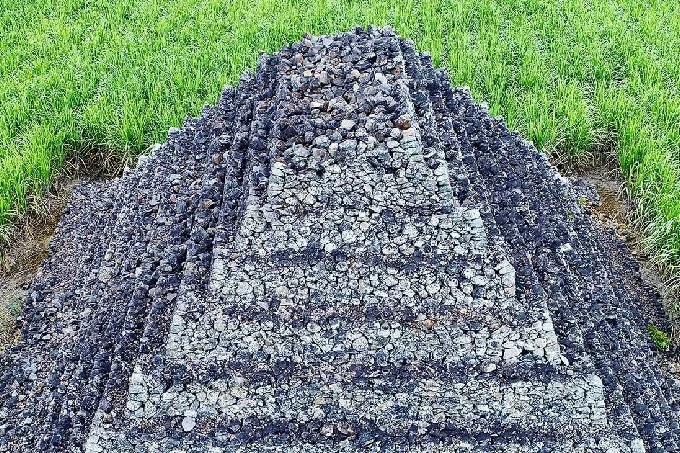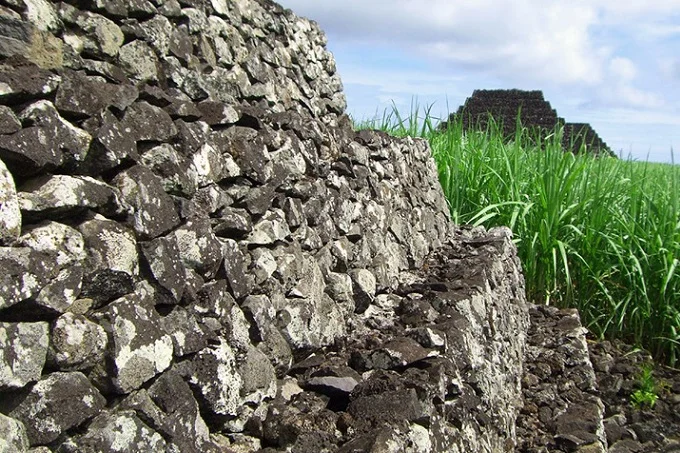Facts about Mauritius pyramids

Pyramids exist on the island of Mauritius, which lies over a thousand kilometers east of Madagascar in the Indian Ocean. Probably seven pyramids were found there.
The most intriguing aspect is that they are practically an identical replica of the Guimard Pyramids, which are situated on the opposite side of Africa, on the island of Tenerife, and are lost in the immensity of the ocean. Both visually and in terms of construction, the pyramids are quite similar. It is reasonable to believe that the projects on both islands are the product of the same builders’ efforts.
The existence of pyramids in Mauritius was discovered around the turn of the twentieth century. However, after multiple missions, they became known to the broader public in 2008. Antoine Gigal and a group of archaeologists did the first research. They discovered numerous half-filled pyramids as well as the ruins of other cyclopean buildings. The pyramids might be 10,000 to 20,000 years old, according to different experts’ estimations.
The island of Mauritius was initially charted in 1502 by Italian Alberto Cantino, and the first Portuguese sailors arrived in 1507. It’s possible that Arab mariners were aware of the island’s existence as early as the ninth century. Later, the Mascarene Islands were dubbed Dina Margabin, Dina Harobi, and Dina Morare (Reunion, Mauritius, and Rodrigues respectively).
The ancient Phoenicians, an adventurous race who embarked on lengthy sea voyages, may have known about Mauritius. Periplus narrates the narrative of Hanno (Hannanus), a Carthaginian navigator who lived in the fifth century B.C., whose ships sailed out to explore the African coast of the Atlantic Ocean after crossing the Strait of Gibraltar.
By command of Egyptian Pharaoh Necho II (610-595 BC), Herodotus relates a Phoenician expedition that crossed the Red Sea and reached the Mediterranean via the Strait of Gibraltar, skirting the “sea to the south.” This indicates that the expedition made a complete round around Africa.
Mauritius was deserted in some form or another when the Portuguese discovered it in the early 16th century. The island was called after the Latin version of the name Moritz of Orange when the Dutch seized it in 1598.
Originally, the island was primarily used as a stopover for commerce ships. The earliest Dutch colony on the island occurred in 1638, and Simon van der Stel is said to be the first kid born there. Mauritius gradually started to build sugar cane, cotton, tobacco, and animal plantations. This was accomplished by bringing in slaves from Madagascar.
The pyramids are 10 minutes from the airport, in a tight clump in the midst of empty farmland. Tourists are not escorted to the pyramids; there is no mention of them in guidebooks, and no mention of the pyramids is made in documentaries about the island. Locals are also not especially enthusiastic about the topic.
Initially, the country’s government granted the pyramids a protected status, which they almost lost later. It has to do with the change of administration in 1968, which marked the end of Mauritius as a British colony.
Some academics now claim that the pyramids are stacks of stones that local peasants bent when cleaning sugar cane plantations. However, they would have required an engineering design, 30 000 tons of stones, and enough labor to construct such a “pile.” “But we know that this island is deserted,” says a well-known song. To assemble one such “pile,” 100 men would have to labor nonstop for at least five years.

Of course, from the perspective of engineers and geologists, the version of the pile of stones is totally ludicrous. Even from space, the angles and foundation lines generated from rough stone are quite precise. The work of competent architects, not slaves who cleared the estates, is undeniable.
However, why was it essential to assemble all of the “piles” in one location? People who can’t believe the pyramids were constructed before the island’s discovery think they were erected to keep the crops wet. Many areas in Mauritius have stone piles, however, they all have a distinct appearance.
The pyramids were recently inspected by Sam Semir Osmanagich, the guy who found the Bosnian pyramids. Following his excursion, he backed Antoine Gigal and is equally convinced that Mauritius’s pyramids are ancient.
The Mauritius pyramids feature stepped faces and a distinct rectangular foundation. The number of stages varies between 6 and 13. The pyramids are hardly more than 12 meters tall. The pyramid with a base width of 26×26 meters is the biggest. Like those on Tenerife, Pyramids in Mauritius are made entirely of raw volcanic stone, with no mortar or other binding materials. They are fairly sophisticated engineering constructions that need a high level of knowledge and ability on the part of the constructors.
On top of several Mauritius pyramids, a platform might have been utilized for astronomical observations. One of the pyramids even includes a central stairway leading to the summit. The passage is fashioned of a somewhat lighter stone, which makes it stand out.
Another startling coincidence may link the Guimar complex on Tenerife to the Mauritius pyramids. It is believed that on the day of the summer solstice, visitors to one of Guimar’s pyramids might see a unique phenomenon: the Sun sets behind one of the neighboring mountain tops, then reappears on the horizon and sets again.

According to preliminary estimates, the same effect should be seen on Mauritius’ pyramid No. 2, which experts will investigate in the near future. The first sunset will be behind Creole Mountain on the day of the summer solstice, which falls on December 21 in the southern hemisphere, while the second will be behind adjacent Puma.
When comparing Tenerife’s and Mauritius’ pyramids images, it’s impossible to tell which island they belong to. Such a high number of coincidences shows that the islands share something more than just coincidences.
The Antoine Gigal Expedition revealed further remarkable buildings related to the pyramid complex in the immediate neighborhood of the pyramids, covering an area of nearly two square kilometers. Antoine Gigal says that “huge stone walls, paved and planned roadways, and terraced hydraulic systems created of the same material and utilizing the same technique unquestionably date to the same epoch as the pyramids.”
Massive stone walls, erected with great care from the same material as the pyramids, surround the settlement of Plaine Magnien. The walls are 70 to 90 cm broad at the top and 1.5 to 2 meters tall, with a significantly larger base. The base of the wall reaches 5 meters in certain places and is made up of monoliths with a volume of around two cubic meters.
One of the walls, which runs between Pyramids #1 and #2 and the settlement of Mare d’Albert, is more than 600 meters long. The second wall, which resembles an observation platform, is erected directly on the brink of a precipice that drops down into the sea. There are two more barriers that continue into the water to the northeast of this platform. The walls and other buildings are undoubtedly part of the same old complex, and current residents have simply altered them to suit their requirements.

There are also old roadways in Mauritius that link the pyramids and other constructions. The roads have been meticulously designed, sculpted, and constructed to such a high standard that contemporary vehicles traveling over them many times a day do no damage.
The island’s contemporary road system, which needs continual maintenance and substantial financial outlays, contrasts sharply with the island’s historic roadways. The width of the road ranges from 2 to 5 meters. The roadbed is raised above the earth in certain areas to maintain it horizontally. One of the 5 to 10 meter wide roads begins immediately at the pyramids complex and goes for more than 2 kilometers to the sea.
Even farther south are the ruins of a massive hydraulic system that was fed by a neighboring valley’s strong subterranean spring. The system starts with a two-meter-deep canal in the first basin, which is lined with flat stone slabs at the bottom. The other pool is 100×26 meters and is about six meters deep. The pool is surrounded by huge walls that have the same qualities as the pyramids.
A 30-meter platform is located nearby on the south side of Bouchon Beach. At the base of the platform is a massive wall that is 4 meters high and roughly 2 meters wide. The bottom of the wall is rather level and straightforward to scale. The whole construction resembles a snake’s body with a flat platform on top.
Two odd constructions may be seen in the Pont Naturel area. A hole in the rock with a clearly rectangular form is one of them. The hole is limited on one side by an arch that hangs 30 meters over the sea.

The waves produce a pressure of air that explodes through the opening, making terrible noises that can be heard for miles. A sea geyser, positioned on a conspicuous rock in the sea and linked to the coast by a small isthmus, is another structure. There is a hole in the rock, and the ocean waves underneath it produce pressure, causing water to be thrown up to 40 meters in the air.
Pyramid complexes in Sicily, the Canary Islands, and now Mauritius are identical twins, indicating that we are dealing with an undiscovered maritime civilization capable of erecting such structures on several parts of the African continent.
Nothing is known about the pyramids’ origins, the purpose of their building, or the builders themselves at this time. One thing is certain: neither Europeans in the 16th-19th century nor Arabs in the 10th-11th centuries constructed the pyramids. But by whom, then?





What is this fantasy? They were built in 1944 by a sugar company to clear the canefields of stones.